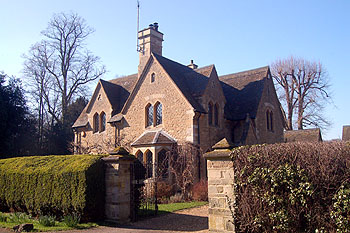
The Little House March 2011
The Little House was listed by the former Department of Environment in August 1983 as Grade II, of special interest. The house was built by the Bedford Estate in 1857. It is constructed of coursed limestone rubble with ashlar dressings and has a red and purple patterned tile roof with crested ridge tiles. Accommodation comprises one storey and attics.
The house formed part of the outbuildings of Oakley House. Oakley House was remodelled about 1795 by Henry Holland for the Duke of Bedford. The Dukes had owned the Oakley House Estate since 1737 as Lords of the Manor of Oakley Reynes. The Duke decided to sell the estate by auction in October 1918 [AD1147/18] but in the event withdrew Oakley House and its outbuildings from the auction as he decided to sell it privately to his cousin the 2nd Baron Ampthill. The particulars detailed The Little House as follows:
The Gardener's Lodge
Stone built and tiled, containing eight Rooms. Outbuildings - washhouse, bakehouse, Barn and two Earth Closets.
Directories for Bedfordshire were published every few years (not annually) from the mid 19th century until 1940. Gardeners to Oakley House are listed from 1847 until 1931. In the following list the dates are not those of appointment and resignation, simply the first and last dates they are mentioned in directories.
- John Taylor 1847-1864;
- Charles Russell Clarke 1877-1894;
- Thomas Pepper 1898-1914;
- Joseph Hart 1920-1931.
Kelly's Directory for 1940 lists the Little House which was evidently no longer a gardener's property but something more up-market as it was then occupied by Major Charles Gude.
Joseph Hart and his wife Emily suffered a tragedy during the First World War. The Commonwealth War Graves Commission website lists his son, Lance Corporal Harry James Watson of the 1st Battalion, Lincolnshire Regiment, as having been killed on 21st March 1918, aged 28. He has no known grave and is commemorated on the Pozieres Memorial to the Missing on the Somme. 21st March was the first day of a massive German offensive against the British Armies in France and Flanders which drove them back around fifty miles in the space of a month and brought the Germans within reach of the railhead of Amiens. Had that fallen the Germans might have been able to sue for an advantageous peace. As it happened the British line held firm and, with increasing numbers of Americans arriving in France the allies launched an offensive of their own in early August which, a hundred days later, ended the war with the Armistice.
The 1st Lincolns were part of 62nd Brigade of 21st Division and were unique in that a detachment of two officers and 125 men from the Bermuda Rifle Volunteer Corps served as part of the battalion from June 1915 until the end of the war - suffering 75% casualties. The division was in hastily constructed defences near Saint Quentin on 21st March and, due to the lack of proper trench works and the fact that the British troops were strung out very thinly having had to take over large tracts of front line from the French at a time when there were no replacements being sent from England so that divisions previously twelve battalions strong were reduced to nine battalions at the time.
The Rating Valuation Act of 1925 specified that every building and piece of land in the county was to be assessed to determine the rates to be paid on it. Oakley, like most of the rest of the county was assessed in 1927. The valuer visiting The Little House [DV1/C115/32] found it comprised two parlours and two kitchens with four bedrooms above. It had previously been divided into two. Accordingly two barns and two earth closets stood outside.